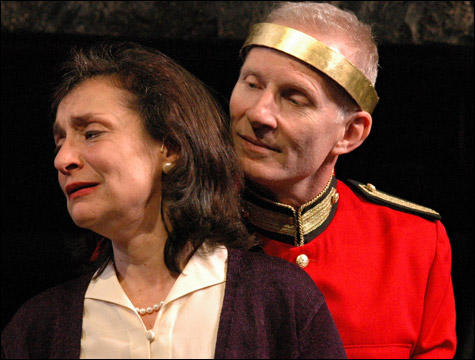
RICHARD III: Brian McEleney (here with Phyllis Kay) is most effective as the haunted monarch of act five. |
At Trinity Repertory Company, under the galvanic direction of Kevin Moriarty, Richard III is a thing of additions and subtractions, at the center of which is Brian McEleney’s limping, lascivious, gleefully two-faced Dick Crookback. The modern-dress production (which continues through March 2) begins in a burst of gunfire and music by Arcade Fire as camouflage-clad soldiers thunder across the bombed-out-looking set, some sidling up a lattice at the back of the playing space, quickly recapping York attacks on the house of Lancaster from the end of Henry VI, Part Three. These include the offing of crown prince Edward and Richard’s assassination of Henry, who prophesies “much more slaughter” by the runt of the York litter. As a red-lit, gowned and tuxedo’d court sweeps on, Richard’s older brother retakes “England’s royal throne” as Edward IV. Only then does our antihero, sans physical deformities but with a stiff leg strapped into a plastic splint, launch into the arch opening speech of Richard III, with its punning allusions to the sun of York and its declaration to an accomplice audience that “since I cannot prove a lover/To entertain these fair well-spoken days,/I am determined to prove a villain” — an aim he proves is true.
But fear not that the prequel/prologue will make the main event longer than Angels in America. As he did when he directed a swinging-singles-apartment-complex-set The Merry Wives of Windsor, Elliot Norton Award winner Moriarty makes bold cuts, including the Bishop of Ely’s strawberries and Henry VI’s widow, cursing Queen Margaret, a bit of whose scalding invective is put into the mouth of Richard’s disenchanted mother. Here the Duchess of York decries “the kennel” of her own womb for bringing forth the ruthless Richard!

The director’s audacity does not stop there. The production gallops like the horse for which Richard famously offers his kingdom (here in a troubled dream rather than on Bosworth Field), the dead bodies from one scene being hauled off like sandbags as the next scene cranks up. And when Richard interrupts his manipulation of his fellow characters to confide his self-delighted villainy to the audience, he snaps his fingers and the lighting abruptly snaps as well — from amber and atmospheric to bright white. When he exits his own mind and re-enters the scene, another snap reverses the effect. Of course, in addition to placing the Machiavellian from whom Queen Elizabeth’s progenitors wrestled the crown in a very bad light, Richard III means to demonstrate the seductiveness of evil, especially when we are taken into its confidence. And McEleney’s conscienceless pol, venturing into the aisles to press some flesh and beam some shit-eating smiles, is pretty seductive — in part because everyone else on stage, from an Anne enticed by Richard’s licking her spit from his fingers to a co-conspiratorial Buckingham who thinks himself immune to Dick’s deadliness, is such a sucker.
This is an exciting production, chilling in its clinically enacted violence, which includes garroting, one-handed strangulation, mob-style assassination, and the on-stage clubbing to death of one of the princes in the Tower. Often its Richard travels in the company of impassive thugs Catesby and Ratcliffe (Tyrrel having hit the cutting-room floor), one of whom carries rubber gloves and instruments of torture in a gleaming metal suitcase. My cavil is that there is little nuance in McEleney’s Richard — despite the character’s initial appraisal of himself as “subtle, false, and treacherous.” The actor’s audacious, red-haired hellhound garners a lot of laughs with his turns on a dime from unctuous tears and sucking up to unmasked revelry in his villainy. But it’s hard to believe even a brilliant strategist like Richard would win his murderous chess game by so overdoing the acting. I liked McEleney’s Richard better after he’d merrily slaughtered his way to the crown and had to start obsessing about keeping it. The haunted monarch of act five, with no pity for himself and grimly alive to the fact that the murderer in the tent is he, is more formidable, even on his doomsday, than the razor-sharp plotter hee-hawing at his own perversity.
The placing of Richard III, Shakespeare’s breakout play, in the broader setting of the War of the Roses (artistic director Curt Columbus compares the Henry VI trilogy and its dramatic successor to the Star Wars cycle) is not a bad idea — especially if the intent is to draw parallels with the partisan, some might say malevolent, politics of today. Certainly Michael McGarty has designed an effective metaphor of a set; gray and brutalist, it looks like a one-time edifice that’s been smashed, its pinions skewed beneath broken hunks of concrete. A few of the supporting performances are similarly muscular, especially Phyllis Kay’s as a Queen Elizabeth whose hatred and sarcasm bristle. To Richard’s ally, “the deep-revolving, witty Buckingham,” the very natural Fred Sullivan Jr. brings an Irish-tinged jocularity and the street smarts of a kingmaker.